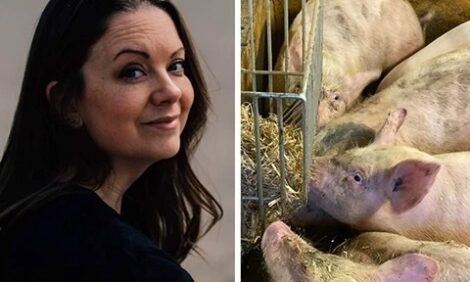



PEDv Impact on Pig Prices and Supply – A Look at 2015, 2016
Porcine Epidemic Diarrhea virus (PEDv) drove supply down in 2014 and boosted prices to all-time highs. However, the lack of PEDv in 2015, as producers feared and prepared for continued high levels of PEDv but didn't see them, has left the US with abundant supply levels and plummeting prices, writes Sarah Mikesell for ThePigSite.“The market anticipated this scenario to some degree and could handle it, which is why when you look at US prices, especially the last couple months, they have been at very low levels,” said Will Sawyer, Protein Analyst, Rabobank.
“When we think about 2015, it's the lack of PED that is really the story - it's a yin and yang where we had such tight supplies in '14, but now we've got more than we were expecting in 2015, so the volatility has been unbelievable in supply but especially in prices.”
Looking into 2016 and the next three to five years barring any disease issues, Sawyer expects to see a much more normal level of price volatility and overall supply growth than what the industry has seen the last two years.
The US saw about an 8 per cent increase in pork supply, made even more challenging in a year that exports were challenged by the US dollar and by the West Coast ports slow down.
“Several issues drove trade down nearly double digits during the first half of 2015. We had supply growth, or production growth, and then without the exports we had even more pork supply in the US to deal with,” Sawyer said. “When you put that together with an 8 per cent increase in domestic pork supply, that's pretty significant. It's by far the biggest in probably the last decade if not more than that, and that’s the major driver of where pork prices are today.”
What's significant from a producer standpoint is, even with these lower prices, US feed costs have been much more manageable than they were four or five years ago. Despite lower prices, profitability is likely to be at break even or slightly above that level for a 2015 average basis.
Steve Meyer, Vice-President, Pork Analysis, EMI Analytics, said the PEDv production impact this past year has not been significant with a lot fewer sow farm cases being reported the winter of 2014/2015.
“If we look at US litter sizes since the fall of 2013 and the first half of 2014, we're moving back on track. In fact, per the USDA the September-November pigs per litter was record large,” Meyer said. “We've lost a year or so in our upward trend for litter sizes, but at least going into this winter, we're back on about a 1.8 to 2 per cent growth curve. That trend was 7 years old when we got hit with PEDv in 2013.”
Prices are significantly lower in 2015 compared to year-ago when they were driven sharply higher by the shortage in market hog supplies because of PEDv losses. However in 2014, production ended up only 1.4 per cent smaller than in 2013, Meyer noted.
“We still ended up with pounds of pork close to the year before, but we did that largely by adding weight,” Meyer said. “There was some panic buying, and we saw record-high prices. Prices in 2015 have been much more normal.”
Lower cash prices are in part due to issues with exports and the stronger US dollar, Meyer said. Barring any resurgence of the kind of death losses seen in 2013 and 2014, 2015 prices are much more in-line with prices moving into the future.
GLOBAL DRIVERS
Globally, the story is China, who drives the market more than any other country.
“China controls about half of world pork consumption, and the fact that supply there has fallen so significantly the last two years means that prices have risen,” Sawyer said. “We, as a bank, see a lot of opportunity for the west - Canada, the US, Europe - to really fill that void.”
Economically, China's in transition, but what Sawyer finds interesting is that a lot of Chinese producers are now entering the pork industry.
“It's a process of China becoming a more commercial, industrial producer instead of the backyard producer as it has been for decades, but it's going to take time. We’ve seen a lot of producers exit the industry - about 20 per cent of their breeding herd has come out of supply,” Sawyer noted.
The lower Chinese supply has meant a lot of countries, especially in the European region, have sent significantly more pork supplies into China, especially in the last few months. This is expected to continue into 2016 if pork prices remain quite high.
To be clear, disease is always a problem for livestock producers in China, but PEDv was not an abnormally big issue this year.
“PEDv isn’t a disease that's ever going to go away in China - at least not in the next several years. While we did see the supply contraction, it wasn't driven by disease,” Sawyer said.
Mexico
In 2015 Mexico continued to deal with PED. By all reports, it appears they were hit similarly to the US, but their recovery has been slower, and it's still a challenge for many Mexican pork producers.
“While Mexico is very similar to the US in many ways, from a commercial industrialization standpoint, they're not where the US is, so eradicating the virus has been tougher for them,” Sawyer said. “While that's a challenge for Mexico, it has actually been a good thing for the US because as we've recovered, we were able to send more pork product into the Mexican market.”
Canada
Canada has experienced far fewer issues with PEDv, with a few cases reported in the Ontario region. And Canada didn't see a supply hit in the same way that the US did.
“Time is on everybody's side when it comes to these viruses, and being the first one hit is never much of a benefit. The fact that Canada saw what the US experienced and how to deal with it - how to try to minimize it - that was a big benefit,” Sawyer said.
Spreading the virus through the feed supply was one that Canada identified quickly and addressed it. Another benefit on Canada’s side is that from a geographic concentration, their production is far more dispersed than in the US, so there’s less of a density issue.
Europe
As for Europe, Sawyer said they are dealing with African Swine Fever outbreaks in eastern Europe, but PEDv has not been a significant issue in that region.
PEDv Forecast for 2016
From a production standpoint, Meyer said the jury is still out on 2016.
“We've just gone into the season for this virus to be much more easily spread. It lives outside of the host much better in cool, damp conditions than it does in the summertime, so we've seen the number of sow farms and the number of case accessions going up over the last 5 to 6 weeks,” Meyer said. “The number of sow farm cases breaking is higher than it was a year ago, which we expected.”
Meyer said the US industry went into last winter with a lot of sow farms immune to PEDv because they'd been through a break the winter before, but this year the immunity to PEDv isn’t there. The expectation is that there could be more sow farms with PEDv.
Sawyer said US cases of PEDv need to be taken at a far discounted level than a year or two ago, and that's because producers are much better at handling and containing the virus, and vaccines are available now that weren't around when the outbreaks began, Sawyer said.
Because producers are confident that they can manage PEDv, they don't need to build any cushion in supply like they did going into 2015. The only concern might be a new strain outbreak, but even if that occurred, vaccines should be able to be developed in a relatively short time to counter it.
“PEDv could impact supply to some degree, but I don't see it as a major constraint,” Sawyer said. “Obviously there's a lot of risk out there, but I really think that the volatility the producers have been through is going to come down. When we see opportunity, it's more on the trade side than spreading disease that's going to limit supply.”
In creating Meyer’s initial forecast for 2016 coming out of the September Hogs and Pigs Report, he didn't make any adjustments to the USDA numbers due to PEDv on the assumption that the pig losses would be the same as a year ago. And he is still making no adjustments to the December report data released recently.
“I don't think we're far enough ahead that I'm going to make much change yet,” Meyer said. “We're going to be watching very closely to see if this years' number of PEDv cases and reports of pig losses are greater than a year ago.”
The consensus right now is that it’s likely to be worse than last year but not nearly as bad as the first year.
“I would guess that we're going to have a little bit more piglet loss this winter, but remember that doesn't start impacting slaughter until the summer,” Meyer said.
“Not only did we have a naive swineherd in 2013, we also had naive producers and that isn't the case anymore. Everybody knows so much more now than what they did, and that's one of the reasons I'm going to say, ‘Show me the damage before I start trying to put any impact on it’,” Meyer said. “I think that will be a huge factor in what happens this winter. As long as people don't get complacent, I think we will be fine.”
This article first appeared in the 2016 IPPE Digital.








